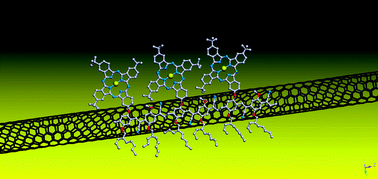Tuning and optimizing the intrinsic interactions between phthalocyanine-based PPV oligomers and single-wall carbon nanotubes toward n-type/p-type†
Abstract
In this work we have developed a strategy to immobilize functional

* Corresponding authors
a
Department of Chemistry and Pharmacy & Interdisciplinary Center for Molecular Materials, Friedrich-Alexander-Universität Erlangen-Nürnberg, Erlangen, Germany
E-mail:
guldi@chemie.uni-erlangen.de
Fax: +49 9131 8528307
Tel: +49 9131 8527341
b
Departamento de Química Orgánica, Universidad Autónoma de Madrid, Cantoblanco, Madrid, Spain
E-mail:
tomas.torres@uam.es
Fax: +34 91 4973966
Tel: +34 91 4975097
c IMDEA-Nanociencia. Facultad de Ciencias, Cantoblanco, Madrid, Spain
In this work we have developed a strategy to immobilize functional

 Please wait while we load your content...
Something went wrong. Try again?
Please wait while we load your content...
Something went wrong. Try again?
J. Bartelmess, C. Ehli, J. Cid, M. García-Iglesias, P. Vázquez, T. Torres and D. M. Guldi, Chem. Sci., 2011, 2, 652 DOI: 10.1039/C0SC00364F
To request permission to reproduce material from this article, please go to the Copyright Clearance Center request page.
If you are an author contributing to an RSC publication, you do not need to request permission provided correct acknowledgement is given.
If you are the author of this article, you do not need to request permission to reproduce figures and diagrams provided correct acknowledgement is given. If you want to reproduce the whole article in a third-party publication (excluding your thesis/dissertation for which permission is not required) please go to the Copyright Clearance Center request page.
Read more about how to correctly acknowledge RSC content.
 Fetching data from CrossRef.
Fetching data from CrossRef.
This may take some time to load.
Loading related content
